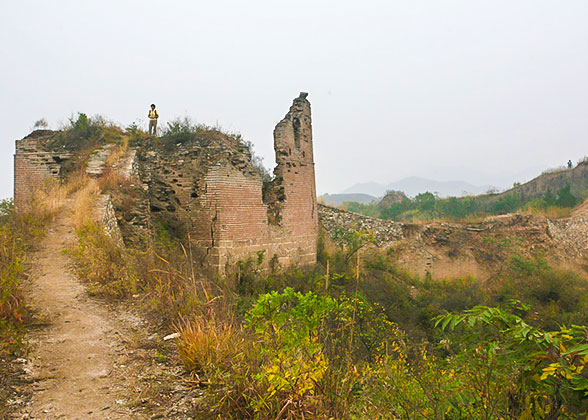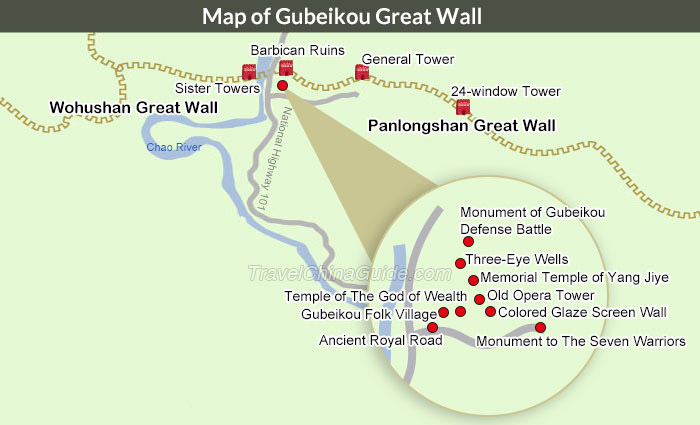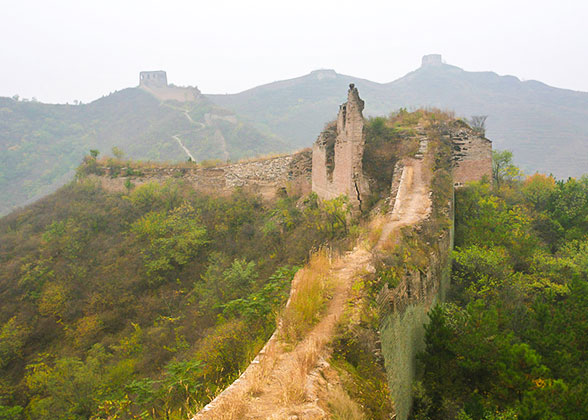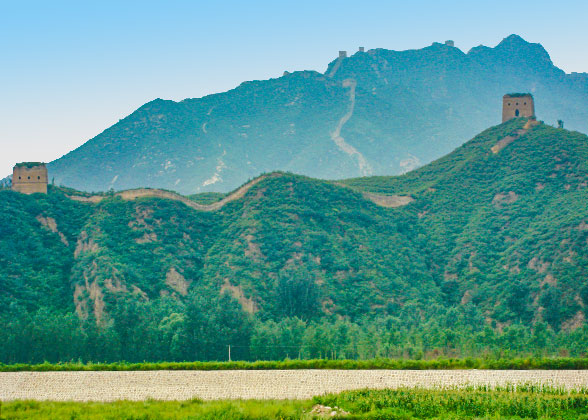The Gubeikou Great Wall has never been reconstructed. Hence, it is somewhat dilapidated but retains its original beauty. It is difficult to access. Many battles were fought here throughout the Chinese history due to its strategic location. Even if they are quite broken, the crawling wall and tough watchtowers will remind you of their past glory.
Double-lined Great Wall

Northern Qi Dynasty Line: Gubeikou was first built during the Northern Qi Dynasty (550-557). In the early
Ming Dynasty (1368-1644), General Xuda was ordered to rebuild it. Its defensive capability was enhanced by adding more stones although only a few relics can be found today. The best-preserved is the Big Flower Watchtower (Dahualou), so-called due to its square shape with 12-arrowed windows, which resembles a blossoming flower when seen from afar.

Ming Dynasty Line: When Qi Jiguang was appointed the chief commanding officer of the Ji Garrison (one of the
eleven garrisons during the Ming Dynasty), he ordered to lay another layer of bricks standing side by side the original one, forming the unique double-layered Great Wall.
 More Gubeikou Great Wall Pictures
More Gubeikou Great Wall Pictures
Basic Facts of Gubeikou Great Wall
 This section was originally named "Beikou", which literally means "Northern Pass", during the Tang Dynasty (618-907) since it is the northern defensive line of Youzhou (today's Beijing). "Gu" (ancient) was only added by later generations.
This section was originally named "Beikou", which literally means "Northern Pass", during the Tang Dynasty (618-907) since it is the northern defensive line of Youzhou (today's Beijing). "Gu" (ancient) was only added by later generations.
 Stretching for about 40 kilometers (25 miles), there are 172 watchtowers, 14 beacon towers, 16 passes, 3 water passes, 3 barbicans, and 6 fortresses along it.
Stretching for about 40 kilometers (25 miles), there are 172 watchtowers, 14 beacon towers, 16 passes, 3 water passes, 3 barbicans, and 6 fortresses along it.
 In the broad sense, it is comprised of four sections: Wohushan, Panlongshan, Jinshanling, and Simatai. But in the narrow sense and to visitors, it is composed of Wohushan and Panlongshan.
In the broad sense, it is comprised of four sections: Wohushan, Panlongshan, Jinshanling, and Simatai. But in the narrow sense and to visitors, it is composed of Wohushan and Panlongshan.
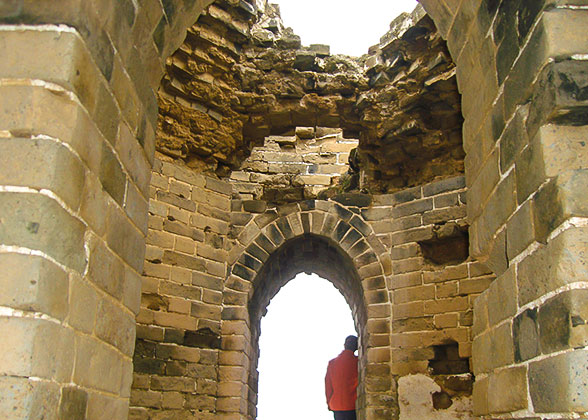 | | Inside a Watch Tower | | 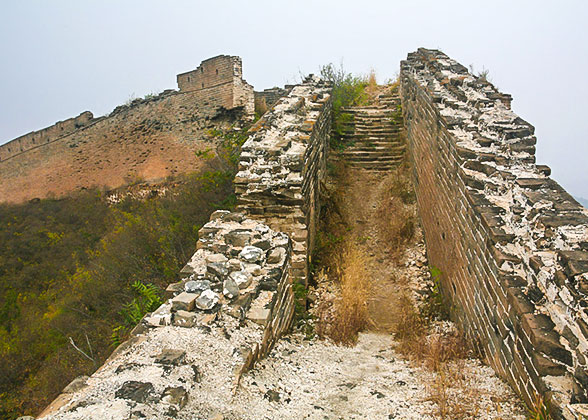 | | Great Wall at Wohu Mountain | |
Wohushan Section
"Wohushan" literally means a mountain resembling crouching tigers, for it looks like two tigers: one lying on its back and the other on its stomach. The Wohushan Section features the unique "Sister Towers". The Elder Sister Tower to the north is higher than the Younger Sister Tower to the south. Seen from afar, they are like two pretty ladies hand in hand. The Sister Towers were used to station troops,store weapons and foodstuffs during the wartime. It is quite rare as they are so close to each other.
Panlongshan Section
The Panlongshan Section features the General Tower and 24-window Tower:

The two-storey General Tower was the commanding office. It is square in shape, with a side length of about
10 meters (
11 yards) and a door on each side. There are four windows on the eastern and western sides respectively, and three windows on the northern and southern sides. The tower is pretty symmetrical. However, the crenels on the top were seriously damaged during the war. Hence, the top has been exposed to the substance ever since.

The 24-window Tower is the last watch-tower at Panlongshan Section. It has three storeys, which is unique. There are three windows on each side on the first and second storey and teeth-shaped crenels on the third storey. The 24-window Tower worked in concert with the General Tower during the wartime. However, the northwestern side of the tower has now collapsed, leaving behind the eastern and southwestern walls standing firm and still.
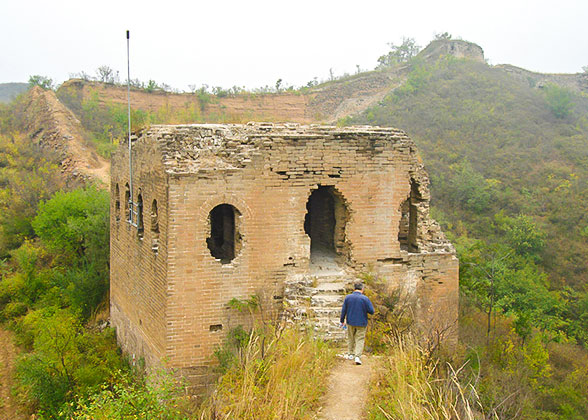 | | Beacon Tower on Panlongshan | | 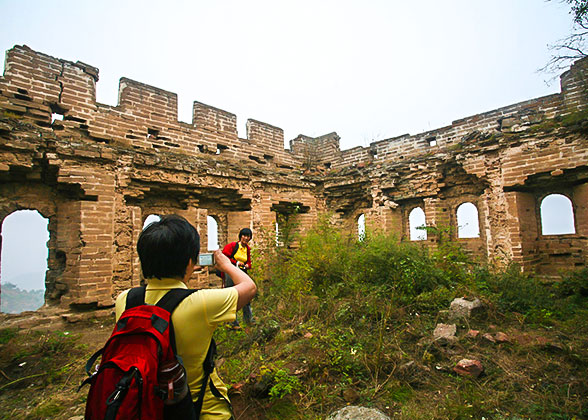 | | A Broken Watch Tower | |
How to Tour Gubeikou Great Wall
 Commence hiking from Gubeikou Town. Ascending the Great Wall requires a lot of energy. The road is narrow and uneven and hence extra care is needed.
Commence hiking from Gubeikou Town. Ascending the Great Wall requires a lot of energy. The road is narrow and uneven and hence extra care is needed.
 The old Wohushan Section on the steep ridges of the mountain lies on the west and where the Sister Towers are. The end of the Wohushan Section lies further on and one have to return the same way as the winding route disallow anyone to go any further due to the steep slope.
The old Wohushan Section on the steep ridges of the mountain lies on the west and where the Sister Towers are. The end of the Wohushan Section lies further on and one have to return the same way as the winding route disallow anyone to go any further due to the steep slope.
 Panlongshan, on the other hand, lies on the east. The magnificent General Tower is about 2 hours away and the 24-window Tower lies along the way. Continue eastwards to the Jinshanling Section. But there is a closed military zone in between, so you need to make a detour.
Panlongshan, on the other hand, lies on the east. The magnificent General Tower is about 2 hours away and the 24-window Tower lies along the way. Continue eastwards to the Jinshanling Section. But there is a closed military zone in between, so you need to make a detour.
 After hiking, you can visit the town itself for there are a number of scenic spots like the King of Medicine Temple, the God of Wealth Temple, and the Memorial Hall of Defense of the Great Wall.
After hiking, you can visit the town itself for there are a number of scenic spots like the King of Medicine Temple, the God of Wealth Temple, and the Memorial Hall of Defense of the Great Wall.
Read more: Gubeikou to Jinshanling Great Wall Hiking
When is the Best Time for a Visit?
The best time to Gubeikou Great Wall would be April, May, September, and October when the temperature is favorable and the scenery is delightful. It is worth mentioning here that a large-scale temple fair is held annually at the King Medicine Temple on September 14th in Chinese lunar calendar.
How to Get to Gubeikou Great Wall from Beijing
It is located in the northeast Miyun County, about 120 kilometers (75 miles) northeast of central Beijing.1. Beijing - Gubeikou Train
Take a train from Beijing North Railway Station or Qinghe Railway Station to Miyun Railway Sttion, change to bus Mi51 Branch Line and ride for one stop to Gubeikou Dianguanzhan, then walk back for 2-3 minutes to the entrance.
| Train No. | Beijing North Departure | Qinghe Departure | Gubeikou Arrival | Fare |
| S501 | 06:56 | 07:10 | 09:23 | CNY 12 |
| S503 | 14:20 | 14:34 | 16:50 |
Bus Mi51 Branch Line departs from Gubeikou Railway Station at 09:40 and 17:10 with the ticket fare of CNY2. If you miss it, hire a cab to the scenic spot directly, costing CNY13 or so.
For return trip, train S502 leaves from Gubeikou at 10:00, while S504 at 17:20. They gets back to Qinghe Railway Station at 12:15 and 19:37 and Beijing North Railway Station at 12:30 and 19:52.
2. Bus No. 980 Express
Hop onto bus line 980 Express from Dongzhimen station to Miyun Xinnongcun; and then bus line Mi 25 to your destination. The overall duration is about 3.5-4 hours.
| Bus No. | Onward Trip | Return Trip | Fare |
| 980 Express | 6:00- 20:00 | 4:30- 18:30 | CNY 17 |
| Mi 25 | 6:10-18:20 | 6:20- 17:30 | CNY 11 |
What & Where to Eat
Bring along some food and drinks with you as there is no vendor up the mountain. After hiking, try out the delicious home-made tofu and traditional food of the local Man people. Taste the delicious local fruit, such as plums, apricots and mulberries.
Further Reading:
15 Wonderful Places to See Snow in Beijing- Last updated on Aug. 29, 2024 by Brenda Lian -
![]() More Gubeikou Great Wall Pictures
More Gubeikou Great Wall Pictures![]() This section was originally named "Beikou", which literally means "Northern Pass", during the Tang Dynasty (618-907) since it is the northern defensive line of Youzhou (today's Beijing). "Gu" (ancient) was only added by later generations.
This section was originally named "Beikou", which literally means "Northern Pass", during the Tang Dynasty (618-907) since it is the northern defensive line of Youzhou (today's Beijing). "Gu" (ancient) was only added by later generations.![]() Stretching for about 40 kilometers (25 miles), there are 172 watchtowers, 14 beacon towers, 16 passes, 3 water passes, 3 barbicans, and 6 fortresses along it.
Stretching for about 40 kilometers (25 miles), there are 172 watchtowers, 14 beacon towers, 16 passes, 3 water passes, 3 barbicans, and 6 fortresses along it.![]() In the broad sense, it is comprised of four sections: Wohushan, Panlongshan, Jinshanling, and Simatai. But in the narrow sense and to visitors, it is composed of Wohushan and Panlongshan.
In the broad sense, it is comprised of four sections: Wohushan, Panlongshan, Jinshanling, and Simatai. But in the narrow sense and to visitors, it is composed of Wohushan and Panlongshan.![]() Commence hiking from Gubeikou Town. Ascending the Great Wall requires a lot of energy. The road is narrow and uneven and hence extra care is needed.
Commence hiking from Gubeikou Town. Ascending the Great Wall requires a lot of energy. The road is narrow and uneven and hence extra care is needed.![]() The old Wohushan Section on the steep ridges of the mountain lies on the west and where the Sister Towers are. The end of the Wohushan Section lies further on and one have to return the same way as the winding route disallow anyone to go any further due to the steep slope.
The old Wohushan Section on the steep ridges of the mountain lies on the west and where the Sister Towers are. The end of the Wohushan Section lies further on and one have to return the same way as the winding route disallow anyone to go any further due to the steep slope.![]() Panlongshan, on the other hand, lies on the east. The magnificent General Tower is about 2 hours away and the 24-window Tower lies along the way. Continue eastwards to the Jinshanling Section. But there is a closed military zone in between, so you need to make a detour.
Panlongshan, on the other hand, lies on the east. The magnificent General Tower is about 2 hours away and the 24-window Tower lies along the way. Continue eastwards to the Jinshanling Section. But there is a closed military zone in between, so you need to make a detour.![]() After hiking, you can visit the town itself for there are a number of scenic spots like the King of Medicine Temple, the God of Wealth Temple, and the Memorial Hall of Defense of the Great Wall.
After hiking, you can visit the town itself for there are a number of scenic spots like the King of Medicine Temple, the God of Wealth Temple, and the Memorial Hall of Defense of the Great Wall.